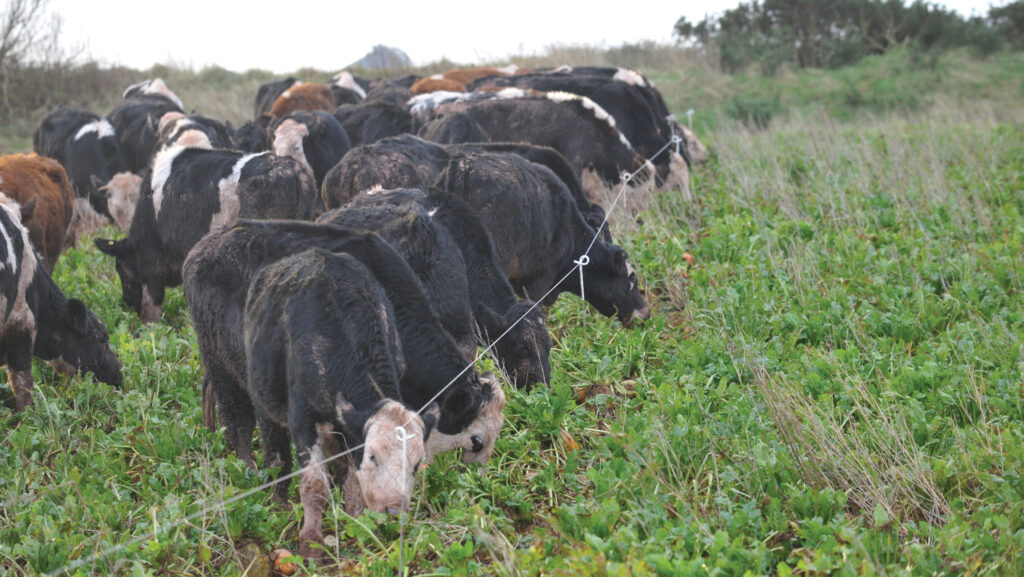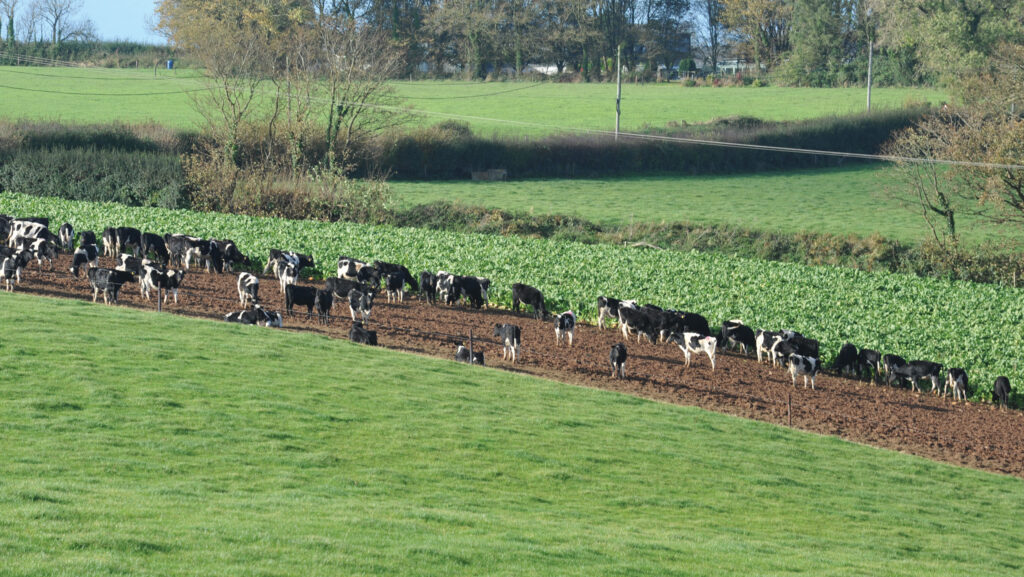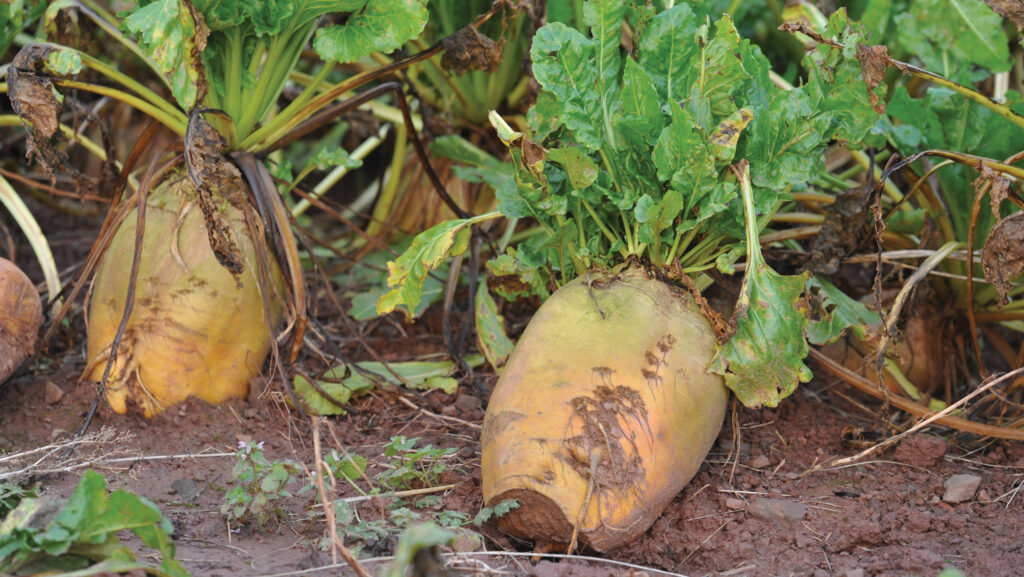Grazing kale versus fodder beet: Which is best for youngstock?
 Heifers grazing kale © Debbie James
Heifers grazing kale © Debbie James To farmers who are unfamiliar with winter grazing fodder crops, kale and fodder beet can appear to provide very similar feeds.
In fact, there are many points of difference, from yield and cattle growth potential to nutritional value and establishment requirements.
Perhaps chief among the differences is how cattle are introduced to the crop.
Independent forage and grass consultant Marc Jones says farmers have traditionally preferred kale for management ease.
Unlike fodder beet, there is little effort needed in transitioning cattle onto the crop.
See also: Tips to help make beet and bale grazing work in a wet winter
“Many farmers just open the gate and let the cattle go, although others will move them back and forward between kale and grass for a couple of days,” he says.
For fodder beet, the transition is more challenging, as the bulbs are high in energy and low in protein.
This is an important consideration when it comes to feeding younger animals.
Transition to fodder beet
“Transition is the key part: if you mess that up, there is a good chance the heifers will get acidosis, and that will put them off eating fodder beet.
“That’s where the technical side of feeding it has to be good,” Marc warns.
Physical signs that the cattle have not transitioned well include very loose dung and being wobbly on their feet.
When these symptoms are evident, he advises withdrawing the animals from the fodder beet and turning them onto grass for a couple of days.
The transition process can then be restarted.
To prevent acidosis, fodder beet intake should be stepped up slowly, ensuring the remainder of the diet is filled with either grass, silage or hay.
Cattle should strip-graze and the fodder beet allocation be increased every other day over a two- to three-week period.
“On day one, 90% of the diet should be grass, moving the cattle backwards and forwards between the fodder beet and the grazing area, and gradually reducing the allocation of grass and increasing fodder beet intakes,” says Marc.

Steers grazing fodder beet © Debbie James
Farmers will know when the optimum daily intakes have been achieved because a proportion of the beets allocated will be left uneaten in the field. They should expect this to be about 25%.
Once cattle have fully transitioned, fodder beet can account for 80-90% of their daily intakes.
Forage quality
Although some farmers will place silage bales in the field instead of providing grass or a green crop, that forage must be of high quality to be suitable for youngstock.
For 200kg R1-type animals, the silage needs to provide 11MJ of metabolisable energy (ME)/kg of dry matter (DM) and 15% protein, says Marc.
“Protein is important for growing the frame, and beet doesn’t have a high protein value – 11-12% compared with 15% in kale.”
As the cattle grow and increase in age, silage quality becomes less of a consideration.
When feeding kale, the supplementary fibre source for 200kg R1 heifers can be grass silage bales, with 30% of the DM requirement provided by these and the remainder by kale.
Rations and growing costs
For 200kg R1 heifers, Marc advises aiming for:
- 3.25kg DM kale
- 3.25kg DM grass or silage; or
- 5.5kg DM fodder beet
- 1kg DM silage.
He says farmers can expect higher daily liveweight gains (DLWG) on fodder beet than on kale.
For 200kg animals, DLWG can be 0.7kg-0.8kg, rising to 1kg as they get bigger, while for kale it is about 0.5kg-0.6kg.
On a cost per hectare basis, fodder beet is three times more expensive to grow, at about £1,500/ha, compared with £500/ha for kale.
However, once yields are factored in, the cost per kilogram is generally similar for both, because fodder beet can achieve yields three times higher than kale.
Choice of variety
For grazing, Marc recommends fodder beet varieties that are low in DM and sit further out of the ground, such as Lactimo or Geronimo. Both of these have a DM content of 15%.
For kale, grazing varieties include the New Zealand-bred Maris Kestrel, which is quite leafy, and the hardy variety Bittern.
Kale carries a risk of high leaf loss when there is a hard frost, and farmers are sometimes concerned that frost damage to the leafy area might cause toxicity issues.
However, Marc says he has never seen this.
“As long as the cattle are grazing it fully and getting a fresh allocation daily, I’m not aware there is a problem,” he says.
Choice of field
As year-round weather conditions have become more demanding, so too have the challenges of growing and feeding forage crops.
Marc admits that last winter’s exceptional rainfall put a lot of farmers off outwintering, but, as he points out, housing systems also had problems, with many struggling with insufficient slurry storage capacity.
“Farmers are still growing fodder beet and kale in good numbers this year but, after last winter, they are making sure they pick their more free-draining fields for outwintering,” he says.
He also advises selecting fields where there is no likelihood of run-off.
“Choose a site where there are no wet patches in the field and it is not too steep.”
Best practice is to provide grass buffer strips of 5-10m around the edge of the field and to exclude stock from these.

© Debbie James
Establishment
At establishment, kale can be direct-drilled, and that means the ground is firmer underfoot at feeding.
Yield is smaller, so cattle can quickly move across the field and there is less risk of poaching.
In contrast, land for establishing fodder beet must be ploughed, as it needs a fine seed-bed for precision-drilling to be effective.
And because it is high yielding, cattle graze smaller areas and are slower to move across the field than those on kale.
“Post-grazing, if it has been a bad winter, kale and fodder beet fields will need to be ploughed, but if the conditions have been favourable, minimum tillage can be used,” Marc advises.
In terms of soil nutrition, because the crops are grazed on-site, the biomass is returned to the soil, which helps to increase soil organic matter.
Fodder beet needs a full season to establish and is therefore planted in mid to late April, whereas kale is drilled in the last week of May.

© Debbie James
Drilled any earlier, kale would reach maturity before it was needed, however, this timing carries some risk.
“Kale is drilled at a time of the year when it can be quite dry, and that means there is a greater risk of getting a bad crop,” Marc says.
“You are more likely to get moisture in April when fodder beet is drilled.”
In addition, when conditions are dry at establishment, it can result in a high level of weed incursion later in the season.
